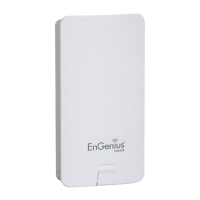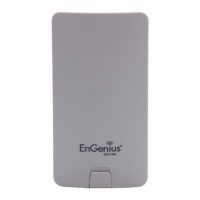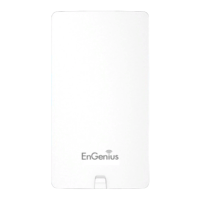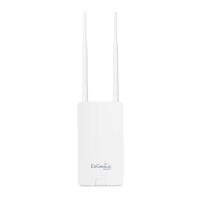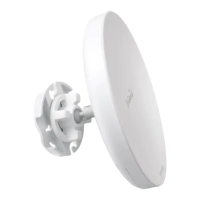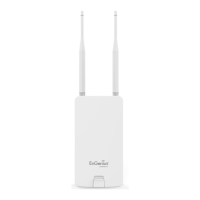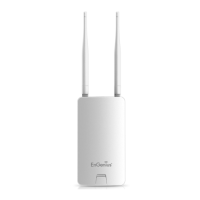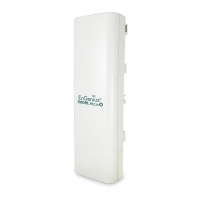Do you have a question about the EnGenius ENS620EXT and is the answer not in the manual?
Provides an overview of the access point's capabilities and intended use.
Lists the main technical capabilities and benefits of the access point, such as range and speed.
Outlines the minimum computer and software requirements for configuring the device.
Lists all the items included in the product package for installation and use.
Details the technical standards, interfaces, power requirements, and operation modes of the AP.
Describes the physical dimensions and identifies the various ports, LEDs, and mounting points on the device.
Guides users on configuring TCP/IPv4 settings for Windows operating systems.
Details the steps for configuring network settings on Apple Mac OS X.
Provides instructions for connecting cables and installing hardware components of the access point.
Explains methods for mounting the access point using wall or pole mounting kits.
Details the procedure for installing the ground cable for lightning protection.
Explains how to access the device's web interface and initial default settings.
Describes the AP's function as a central connection point for wireless clients.
Explains how the AP acts as a wireless adapter to connect to an existing access point.
Details the Wireless Distribution System (WDS) Access Point mode for extending wireless coverage.
Describes connecting different LANs wirelessly using WDS Bridge technology.
Explains how the AP expands WDS by receiving and sharing wireless signals.
Shows general system information, memory usage, and unsaved changes.
Displays client connection lists and WDS link status.
Monitors current traffic loading and active network connections.
Configures the device's IP address, subnet mask, and gateway.
Sets up STP to prevent network loops and manage topology.
Configures device name, band steering, and frequency preferences.
Sets operation mode, wireless mode, channel bandwidth, and transmit power.
Configures security modes like WEP, WPA-PSK, and WPA-Enterprise.
Controls network access based on client MAC addresses.
Regulates traffic flow and sets download/upload limits per SSID.
Enables seamless client roaming between access points.
Configures Wireless Distribution System links between access points.
Creates a separate network for guest access with specific security.
Assigns VLAN tags for managing network traffic.
Configures Simple Network Management Protocol settings for device monitoring.
Sets up email notifications for system events.
Sets the device's internal clock and daylight saving preferences.
Configures automatic reboot schedules for the access point.
Creates schedules to enable or disable Wi-Fi access based on time and day.
Provides tools for ping tests and traceroute analysis.
Configures speed tests and controls device LED indicators.
Scans the network to discover connected devices and their firmware versions.
Manages administrator account credentials and firmware upgrades.
Saves current configurations and restores them from backup files.
Views system event logs and configures remote logging functions.
Logs out of the system or resets the device to default settings.
Provides information on FCC compliance and potential interference.
Details European CE compliance and relevant directives.
Provides an overview of the access point's capabilities and intended use.
Lists the main technical capabilities and benefits of the access point, such as range and speed.
Outlines the minimum computer and software requirements for configuring the device.
Lists all the items included in the product package for installation and use.
Details the technical standards, interfaces, power requirements, and operation modes of the AP.
Describes the physical dimensions and identifies the various ports, LEDs, and mounting points on the device.
Guides users on configuring TCP/IPv4 settings for Windows operating systems.
Details the steps for configuring network settings on Apple Mac OS X.
Provides instructions for connecting cables and installing hardware components of the access point.
Explains methods for mounting the access point using wall or pole mounting kits.
Details the procedure for installing the ground cable for lightning protection.
Explains how to access the device's web interface and initial default settings.
Describes the AP's function as a central connection point for wireless clients.
Explains how the AP acts as a wireless adapter to connect to an existing access point.
Details the Wireless Distribution System (WDS) Access Point mode for extending wireless coverage.
Describes connecting different LANs wirelessly using WDS Bridge technology.
Explains how the AP expands WDS by receiving and sharing wireless signals.
Shows general system information, memory usage, and unsaved changes.
Displays client connection lists and WDS link status.
Monitors current traffic loading and active network connections.
Configures the device's IP address, subnet mask, and gateway.
Sets up STP to prevent network loops and manage topology.
Configures device name, band steering, and frequency preferences.
Sets operation mode, wireless mode, channel bandwidth, and transmit power.
Configures security modes like WEP, WPA-PSK, and WPA-Enterprise.
Controls network access based on client MAC addresses.
Regulates traffic flow and sets download/upload limits per SSID.
Enables seamless client roaming between access points.
Configures Wireless Distribution System links between access points.
Creates a separate network for guest access with specific security.
Assigns VLAN tags for managing network traffic.
Configures Simple Network Management Protocol settings for device monitoring.
Sets up email notifications for system events.
Sets the device's internal clock and daylight saving preferences.
Configures automatic reboot schedules for the access point.
Creates schedules to enable or disable Wi-Fi access based on time and day.
Provides tools for ping tests and traceroute analysis.
Configures speed tests and controls device LED indicators.
Scans the network to discover connected devices and their firmware versions.
Manages administrator account credentials and firmware upgrades.
Saves current configurations and restores them from backup files.
Views system event logs and configures remote logging functions.
Logs out of the system or resets the device to default settings.
Provides information on FCC compliance and potential interference.
Details European CE compliance and relevant directives.
| 2.4 GHz | Yes |
|---|---|
| Modulation | 16-QAM, 64-QAM, 256-QAM, BPSK, CCK, OFDM, QPSK |
| Operating modes | Access Point (AP), Client Bridge, Client Router, WDS |
| Channel bandwidth | 5850 MHz |
| Transmitting power | 27 dBmW |
| Networking standards | IEEE 802.11a, IEEE 802.11ac, IEEE 802.11b, IEEE 802.11g, IEEE 802.11n |
| Virtual LAN features | Tagged VLAN |
| Ethernet LAN data rates | 10, 100, 1000 Mbit/s |
| Maximum data transfer rate | 867 Mbit/s |
| Security algorithms | 802.1x RADIUS |
| Number of SSID supported | 16 |
| Antenna features | Detachable antenna |
| Antennas quantity | 4 |
| Antenna direction type | Omni-directional |
| Antenna gain level (max) | 5 dBi |
| AC input voltage | 24 V |
| Power consumption (max) | 15 W |
| Internal | No |
| Placement | Wall |
| Certification | FCC, CE |
| Product color | White |
| International Protection (IP) code | IP55 |
| Storage temperature (T-T) | -30 - 80 °C |
| Operating temperature (T-T) | -20 - 60 °C |
| Operating relative humidity (H-H) | 0 - 90 % |
| USB 2.0 ports quantity | 0 |
| Ethernet LAN (RJ-45) ports | 2 |
| Cables included | LAN (RJ-45) |
| Harmonized System (HS) code | 85176990 |
| Depth | 114.3 mm |
|---|---|
| Width | 191.6 mm |
| Height | 47.7 mm |
| Weight | 504 g |
